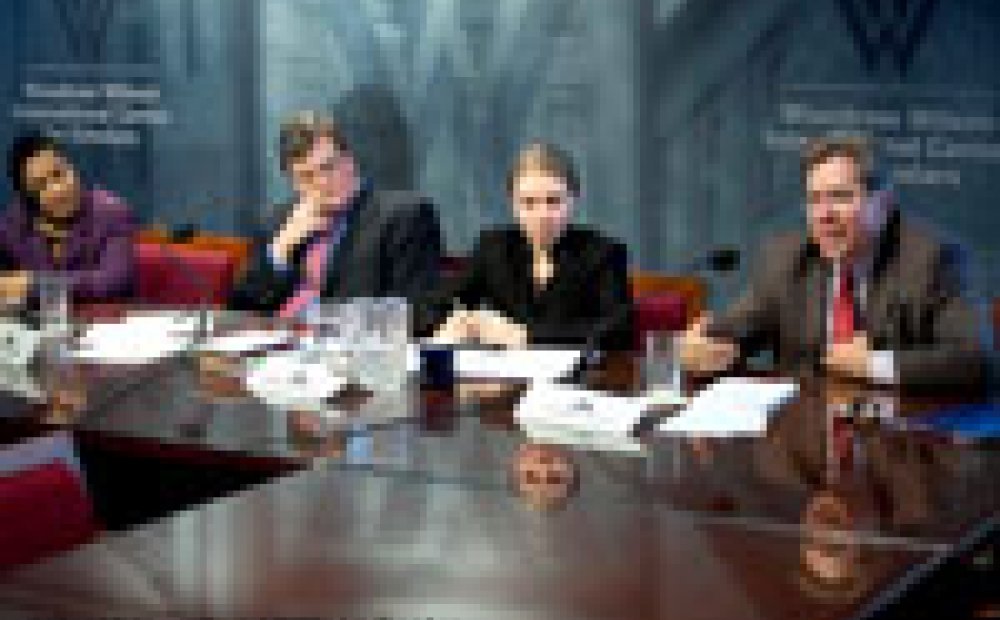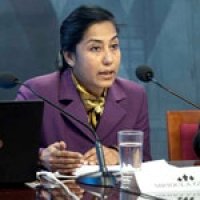Demography, Migration, and Tolerance: Eurasian Experience in Context

As Russia and Ukraine face growing population decline, immigration and integration ought to be increasingly important issues for both governments and civil societies of receiving countries. At a 29 April 2010 Kennan Institute seminar, Mridula Ghosh and Marya Rozanova discussed the administrative and social challenges facing migrants in Ukraine and Russia today, respectively. Andrew Selee, Director of the Mexico Institute at the Woodrow Wilson Center, gave insight on the similarity of the migration experience between Eurasia and North America.
Mridula Ghosh, Board Chair, East European Development Institute, Kyiv, began by discussing the changing trends of migrant labor in Ukraine. Ukraine's population is falling (as is characteristic of other post-Soviet states) and the number of people emigrating are higher than the numbers of immigrants coming in. Some policy responses have been to support higher birth rates, facilitate visa-free travel across borders, and accede to international treaties that ensure better rights for migrants. At the same time, new influxes of migrants are giving rise to xenophobia, racism, and abusive police practices.
Ghosh identified several impediments to successful immigration and integration policy in Ukraine. The government does not have systemized data about migrant backgrounds, such as information about their countries and cultures of origin. For example, all migrants from Africa are listed as "African," so that no official distinction is made between the various states of that continent. In addition, imperfect enforcement of existing legislation leads to abuse of power and free reign in its interpretation, which in turn causes a low level of adherence to international treaty commitments. Ghosh also identified a lack of cross-sector public discourse: the link between academia and policymakers is very weak, as is the disconnect between these two sectors and civil society at large.
Better policies are needed because migrants contribute to the diversity capital of their cities by constituting a healthy and tax-paying work force. Many Ukrainian migrants are self-employed entrepreneurs who own their own businesses. They are highly educated, do not feel dependent on the state, and usually organize within their communities. The revenue from foreign student tuition is also beneficial to Ukrainian universities and the cities that host them. On the other hand, Ghosh pointed out that migrants do not present any significant fiscal burden to government due to their limited access to health care and the lack of transparency in their access to the labor market.
While there are no state-supported integration or skill development programs, Ghosh noted that some state institutions have begun to use the term "visible minorities" to refer to immigrants and minorities, which she argues is the "most politically viable term" for referring to this group. She suggested that further opportunities exist to better the migration situation in Ukraine, including widening the debate beyond CIS-based immigrants, promoting deeper interaction between authorities, academia, and civil society, and including immigration potential in development planning and demographic projections. However, progress on the issue is impeded since any talk of migrants and immigration is highly polarized, and usually devolves to a discussion about Russian minorities within Ukraine. "Immigration is not a policy debate but a political debate," lamented Ghosh.Marya Rozanova, Associate Professor, Admiral Makarov State Maritime Academy and Head of the Center for Civil, Social, Scientific, and Cultural Initiatives "STRATEGIA", St. Petersburg, and Galina Starovoitova Fellow on Human Rights and Conflict Resolution, also discussed changes in migration policy and integration policy, but focused on Russia and specifically on St. Petersburg. The city is the second highest migrant-receiving city in Russia (Moscow is first) and Russia itself is the second highest migrant-receiving country (following the U.S.). Perhaps more than any other country in Eurasia, Russia's population decline is most worrisome, and therefore immigration is crucial to sustain population levels. Rozanova cited data projecting that by 2051, immigrants and their descendants will comprise 50 percent of the Russian population if the current rate of natural population decline continues and population numbers are to be maintained at the same level.
Because of the visa-free regime within CIS countries, a profile of Russia's migrant influx in 2008 shows that most labor came from Tajikistan, Uzbekistan and Ukraine, although approximately 70 to 80 percent of these people remain "invisible" because of their irregular status. Of this new labor influx, 70 percent of migrants come from small towns and villages, with half having no professional education and most coming from impoverished backgrounds. 41 percent are Muslim or come from Muslim states, and the number that does not speak Russian is 9 percent and rising. Moreover, these migrants are not all temporary workers: more than half remain in Russia long-term, and one-third want to gain legal residency. However, they face a highly restrictive federal legislative system and a complicated process of acquiring Russian citizenship.
"Like the United States, Russia is 'multinational,' but that does not mean it is diverse," said Rozanova. Many Russians have negative attitudes toward both international and internal migrants from other regions; 61 percent support the government's restricted migration policy towards migrants and immigrants. Indeed, Rozanova likened the situation to the U.S., where 70 percent of immigrants live in 6 states, and one can find many areas in the U.S. that have never experienced immigrants moving in nor do they have the infrastructure to integrate them.
In St. Petersburg, a lot of migrants also contribute to low levels of integration by self-segregating themselves. Arriving from small villages, a majority of newcomers have no experience living in multicultural and urban environments and come from societies where non-traditional modes of life are not usually accepted. Consequently, these groups keep to themselves within the city and contribute to the polarization of society.
Rozanova concluded by urging that migration and integration policy must be improved on the local, regional, and federal level, with a particular emphasis on the latter. Without an efficient federal migration policy that supports an inclusivity of migrants, the receiving regions are not capable of implementing their own productive models of migration policy. "Without systemic changes, it will be hard to achieve positive results," said Rozanova.Andrew Selee, Director of the Mexico Institute at the Woodrow Wilson Center, concluded with the similarities between immigration issues in Eurasia and the the United States. He noted that migrants coming into Ukraine, Russia, and the U.S. are usually able to find employment with no difficulties, and in all three countries migrants desire to become long-term workers. Some negative similarities include the countries' restrictive legal regimes, lack of state-supported integration programs, and xenophobia driven by cultural factors.
Selee also discussed a phenomenon occurring among migrants in the U.S. whereby they are becoming empowered through their community organizing to engage with the political system and form political coalitions of their own, whether to push a pro-immigrant or anti-immigrant agenda. Selee asked the two participants whether this activism is a possibility for migrants in Ukraine and Russia. In the former, Ghosh responded that the issues dealt with by officials on a political level are not the issues truly pertinent to immigrants. As for Russia, Rozanova answered that this activism would not be very possible for two reasons: first, because immigration policy is almost exclusively the prerogative of the president and the federal government, and second because many of the migrants come from countries that lack strong traditiosn of civil and political engagement.
Despite some differences, the panel revealed that some issues are common to all migrants regardless of their origins or their destinations. Migrant-receiving cities and countries need to seriously amend their policies in order to help migrants integrate into their new communities and to make the process of acquiring long-term residence and citizenship less of an obstacle. The panel agreed that migrants are an important economic and demographic boon, especially for countries with graying populations.
By Larissa Eltsefon
Blair Ruble, Director, Kennan Institute
Speakers


President, Migration Policy Institute

Professorial Lecturer, George Washington University
Hosted By

Kennan Institute
After more than 50 years as a vital part of the Wilson Center legacy, the Kennan Institute has become an independent think tank. You can find the current website for the Kennan Institute at kennaninstitute.org. Please look for future announcements about partnership activities between the Wilson Center and the Kennan Institute at Wilson Center Press Room. The Kennan Institute is the premier US center for advanced research on Eurasia and the oldest and largest regional program at the Woodrow Wilson International Center for Scholars. The Kennan Institute is committed to improving American understanding of Russia, Ukraine, Central Asia, the South Caucasus, and the surrounding region through research and exchange. Read more
